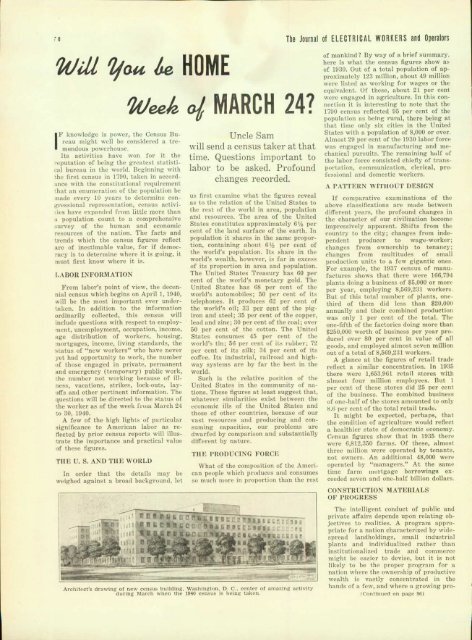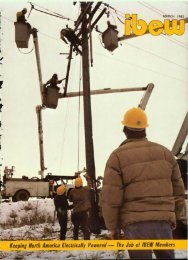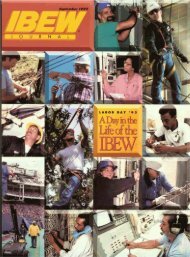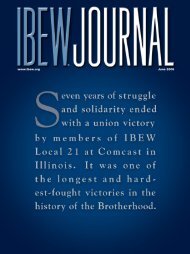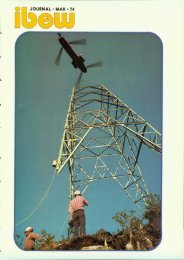t - International Brotherhood Of Electrical Workers
t - International Brotherhood Of Electrical Workers
t - International Brotherhood Of Electrical Workers
Create successful ePaper yourself
Turn your PDF publications into a flip-book with our unique Google optimized e-Paper software.
70<br />
will 4a 4. HOME<br />
I ,knoleicdge is Il.ol..l, the Ccn..us B,-<br />
Ileau lighti well 1t eons, idered a tr-<br />
Its activities have won for it the<br />
putilation of being the greates t stalisti<br />
!ai bureau in tihe wIr.I. legirinnlig withi<br />
lt fir st census ].... 790. taken ill accrd-<br />
,ee wi, h ,he ho nslbi<br />
halt a.. enun. erat.. e<br />
iioial reqiuibreent<br />
f the IitplI.hsttfl..i be<br />
odelidl vex'y 10 yeal to dternllln conessniial<br />
repr teslint itioi, cnslls aietivi<br />
is hav- e,,pand..edI fIon. little m than<br />
I i.Opulati)n count t o i comrprebrnsive<br />
survey of the li oai and ,conomic<br />
resources of the nation. The facts and<br />
re'nls which the census figures r fiect<br />
IrI of instimable value, for if d ..nor<br />
racy is to detsrmine where it is going, it<br />
must rst know where it is.<br />
LABOR INFORMATION<br />
From labor's point of view, the deiennial<br />
census which bgins on April i1, 1940),<br />
,ill be the mist inl por. nt ever unIdertnken.<br />
In addition to the infoirma'll i<br />
raiis. collected, this census. will<br />
include questions with respect to employmierit,<br />
U Cnemploymentit oeeupIaiuo, incolmle.<br />
age distribution of arkern himsilg,<br />
/ortgagies~ income, ivring rtandsdls, the<br />
siltus of workel'q ,new who have ri(ve,<br />
yet had oppolrtunity to work. tlhe i,,lber<br />
of those engaged in private, permSiaent<br />
and Lnergncy ( l....poray) public work,<br />
he .. i.nbe r not wo kirig because oif illnes,.<br />
vacations. strikes. lock-outs, lly<br />
difs and other pertinent itnforllation. 'The<br />
questions will he directed to the status of<br />
ih waolker as of the wek fiorr Malih e24<br />
to 10. 1940.<br />
A few of the high lights of particular<br />
4ignigclanre to American labor as reecoted<br />
by prior ce.nsus reports will illsrnte<br />
the importance<br />
if these figures.<br />
and practical valu,<br />
THE U. S. AND TH E WORLD<br />
In order that thi details ray bhi<br />
wiighrd against a broad backgrou... let<br />
Vee (4 MARCH 24?<br />
ki<br />
Uncle Sam<br />
will sendl a census taker at that<br />
time. Questions important to<br />
labor to be asked. Profound<br />
changes recorded.<br />
usi list .xaine. what the figures eveal<br />
aIs o thi relation of the Ini ted States to<br />
the rest of Ile world inl area, population<br />
andi resoulces. The area of the Ufiled<br />
Stales constitutes approximately 6' per<br />
cent of the lanId surfice of the earth. Ill<br />
pomuhtltlo, it shares in the samne prpor.<br />
tion, containing ahbout (il, per cent of<br />
the worild's population. Is share in th,<br />
wold..s wealth, however, is far in excess<br />
of its proportion ill area and populaion.<br />
The IUnited States Treasury has 60 per<br />
cent of ithr. world's mnnetarv gold. Thie<br />
United States has b8 per cent of the<br />
worMd', automobiles; 80 per enit if its<br />
tlepllones. It produtirs 62 per retL of<br />
the world's oil; 3 per cent of the pigiron<br />
and steel; 35 per cent of the copper.<br />
lead Irel zinc; 30 per Ient of the coal; over<br />
50 per cent of the cotton.. The United<br />
Stats<br />
worhld,<br />
¢onsunmes , 5 pe.r cent of tll<br />
tin; 56 pI el iat of its rbbi-; 72<br />
Ipr cent of its silk;Id4 11cr cent of its<br />
colfee. Its industrial, railroad ail highway<br />
syntems. are by fat<br />
world.<br />
the best ill the<br />
Such is the relative position of tile<br />
United States in the community of nationi,<br />
These figures at least suggest that.<br />
whatever snimilariles exist between the<br />
reennmtic ills of the United Stotem and<br />
those of other countries, because of our<br />
vast Ieroiel.e: and producing and con<br />
sumsing capacities, our problemns are<br />
d warfd by comparison and substntially<br />
differntr by nature<br />
THE IIPRODUCING FOREIC<br />
What of the c.i,.piI.io..h of the Americai<br />
peoleph which iroeduces and coIuntn.es<br />
sn ulruh Inhre in Il .r'polItwin than the rest<br />
Arohitect's drawin, g of new censuS huilding, Wiashingtol, D C.. center of rmzing activity<br />
urilcng March whiol the 1940 Ceisli il 1eillt taker.*<br />
,<br />
--<br />
The Journal of ELECTRICAL WORKERS and Operalors<br />
of mankind ? By way of a brief summury,<br />
here is whal. the censuS figures show as<br />
of 1930. Out of a tolal population of Ipproximaielyv<br />
123 million, b bot 49 million<br />
wri liit . I, as wvorking firo walges or the<br />
eq u ivalenli tit these, ahbo. t 21 per eent<br />
wire ien ased in agriculture. in this con<br />
netion it is iDltrestilbg to note that the<br />
1790 c..nsu reflected 95 per cent of the<br />
popuhiIon ias ng el irrali, tlcrhe being at<br />
that time only six eities in the Enited<br />
States wi itha population of 8,U000 or over,<br />
Almost 29 per cent of the 1930 labor foare<br />
was ell'agedl in manufactu'hing and mIe<br />
chanical pursuits. Tihe lemoaining hal of<br />
the labor (ore coniasted chiefly of transpotltlitin[,<br />
conmuiieatill,. cerical, pro<br />
fessiial and domestic Woikters.<br />
A PATTERIN WIHROUT DESIGCN<br />
If comparative exii.nlanatons of thl,<br />
above cl~assiications, are nl ido between<br />
differert yeas. the proflnd chianges in<br />
the character of our civilization become<br />
impressively apparent. Shifts from the<br />
country to the city; chagres from ulde<br />
pendrll producer to wage-worker:<br />
changs fronm ownership to tenancy:<br />
changes .ion, multitudes of sinal<br />
prdmlutucth, sitfs to a few gigantic ones<br />
For .example, the 1937 census of 1ma,1 -<br />
factIir s shows , that ther were 106,794<br />
plants doing a busiiness of $5J)00 or more<br />
per yar, emp..loying 8,56.69,231 worker..<br />
But of this total nulnlber of plants. onethird<br />
of them did less than $20.001<br />
annually ind lheir cm bined production<br />
was only i per cent of the total. The<br />
one-fifth of the factories doing more than<br />
$250,000 worth of business per year produced<br />
over 80 per cent in value of all<br />
good, anid employed .lmost seven nrillion<br />
out of a total of 8,569,231 workers.<br />
A glance at the figures of retai tradlh<br />
reifect a similar concenutrion. in 1935<br />
there were 1,653,961 rct{il stores with<br />
almost, four million employees. But I<br />
per cent of these stores did 25 per cent<br />
of the business. The combined business<br />
of one half of the stores amounted to only<br />
8.; per eeI iof the totall retail trade.<br />
It might be expected, perhaps, that<br />
the condition of agriculture would reflect<br />
a healthier state of d.emocratic economy.<br />
Cens:Il figures show that in 1915 there<br />
were 6,812,350 farms. <strong>Of</strong> these, almost<br />
three l illitn were opera1ted by ttnnant.<br />
not owlnrs, An additionai 48,000 were<br />
operated by manager" . At the samin<br />
time falin itgage borrowings ex<br />
cerded seven and one-half billion dollars<br />
CONSTlRtCTION MATERIALS<br />
OF I'IROGIESS<br />
The intelligent conduct of public and<br />
private affairs depends upon relating objectives<br />
to realities. A program appro -<br />
printe Ior a nation charactilzed by widesprel<br />
landholdings, small industiali<br />
plants anl individualized rather than<br />
institultonalized trade and eommerce<br />
might ,he aijet to devise, but it is not<br />
likely to Ie the proper program for ii<br />
nation whre the ow nershi p of prodtel ve<br />
wealth is vastly conc e trated in the<br />
hanlls n ai few, and wihl re growing pro-<br />
Cnontinued on page 96)


